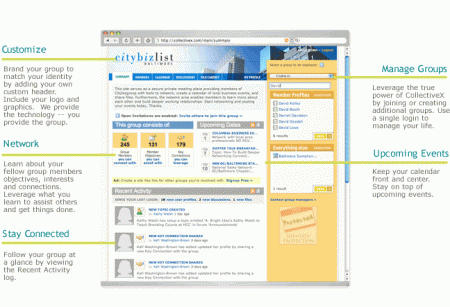Community 2.0

Now there are many publications about the success of community projects (1) of the generation of Web 2.0. There is nothing surprising in this, modern community projects demonstrate a new level of efficiency of interaction with the audience and attract impressive investments. This state of affairs causes the rapid growth of this market segment, and business people rush to get their share in this division. An infinite number of solutions appear on the market, some of which appear to be in quite decent performance. However, units are successful. What is the reason? Let's take a closer look at the bottlenecks when developing community projects:
- Target community identification. Many of the community projects on the market are so vague in their appointment that users simply do not understand what these communities can give them. The idea and goals of the community should be clearly developed and stated in an accessible and visual form. Moreover, the goal of community administrators is to ensure that the community develops in a certain way. As the community grows, goals and topics can be modified according to the wishes of the majority of the target audience. However, in any case, the community must retain its specificity and a certain uniqueness. You can evaluate how different the community projects in the list can be bobstumpel.blogspot.com/2007/03/community-20-update.html
- Expression of individuality. One of the primary motives for the development of communities is the possibility of expressing individuality. Have you ever watched how much time lovers of computer games spend, dressing up your character in the wardrobe items discovered during the game. Exactly the same banal human passion for expressing one’s own individuality, for example, pushes millions of MySpace users to regularly change and modify the look and feel of their personal page using endless gadgets. The analogy with the games is not accidental here. Most of the existing computer games are built on similar principles. There is a certain ranking system and indicators of accumulated gaming experience in the form of a number of specific developing characteristics. As a result, players often spend most of their playing time on “pumping” heroes, sometimes to the detriment of the main missions. The same principle with ranking, indicators of karma and other characteristics allows to encourage the audience to actively participate. Users tend to stand out from the crowd, get into the TOPs, or, for example, be nominated for a virtual award (http://ittoolbox.com/it-community-choice-awards/). However, the ranks themselves do not have much value, and game makers rely on people's curiosity. In games, a simple incentive is offered: show your activity to gain new qualities, activate your newfound abilities to get newer ones. The same principle lies in the participation architecture of Web 2.0 generation projects.
- Regulation of the community within the given ethical standards. This requirement has become apparent in the projects of the generation of Web 1.0. No matter how good the implementation of the community platform is, no matter how wide the audience, if behind a barrage of spam and destructive comments valuable messages are lost, the project is doomed to failure. Web 2.0 solutions are increasingly using auto-moderation systems. For example, a positive majority by voting may limit the activity of “trash generators”. This not only relieves the administration of the project, but objectively regulates the community environment. In fact, this is the path from chaos and further from autocracy to democracy in the community.
- Continuous development of the community platform. If we analyze the success of various recent community projects (see www.startup-review.com/blog/category/communities ), it turns out that many of them took place due to the timely development of the platform in accordance with the wishes and moods of users. The task of the project administration is to follow the life of the community, actively participate in this life, discuss ideas for the development of the project, and if possible take them into account when developing the project.
- Practical user interface. It may be considered that the design and interface of the community project is of secondary importance. However, it should be borne in mind that such projects are created so that users spend as much time as possible in them. As the practice of successful projects shows, there is a demand for a “spacious”, non-annoying design, an easy-to-use, intuitive user interface. One of the cornerstones in this issue is finding a balance between the desire to provide the user with all the potentially relevant information from the first page and the task of “not overloading” the interface, “not scaring” the user with information abundance.
When creating a community project, the following technologies are commonly used: blogs, wiki (web encyclopedias filled by users), user ratings (product ratings, articles, posts, users, etc.), user reviews (often used in film-related communities , music), file sharing, sharing of selected content (on the principle: “found content, showed to a friend”), user comments, Trackbacks (links to the mention of this blog article), Blogrolls (list of user's favorite blogs), Elite profiles, popularity lists (most often blog lists sorted by frequency of mentioning, by attendance, by number of comments), tagging (using tags makes it easy to find information of interest), webcasting (video-conferencing over the Internet), podcasting (publishing in the form of audio ), Video blogging (posting in the form of a video), forums, instant messaging chats / pagers.

But how does all this work in practice? I propose to turn to, for example, which you all know well - www.habrahabr.ru . The project administration artificially nurtures the association of the project idea with its name. In the terminology of the project, the word Habrahabr is constantly played up, which is intended to make it nominal, form and popularize new slang words, as we say, was the case with the google verb. This contributes to the self-identification of community members, both within the project and beyond. For a developing information project, it is not always easy to clearly define a general theme, but a well-marked tag cloud on the Habrahabr pages gives an idea of thematic trends within the project. Information is organized using sections, types, topics, tags, as well as through grouping. This allows us to easily navigate the intensely increasing flow of information, and the tool for maintaining bookmarks and activity history to maintain our own information archive based on the project. However, these are already elements of the participation architecture, which is especially rich in Habrahabr. The project is implemented by the already traditional principle of the Web 2.0 generation community projects - “join, create a network of interesting contacts for you, exchange views within this network”. To express individuality, it is proposed to publish blogs, leave comments, and vote for and against articles and commentaries to them. If you use the terminology from the Forrester technology discussion (http://www.habrahabr.ru/blog/community_life/9928.html), Habrahabr encourages the passive majority of spectators to be active in the life of the community. The ranking system, here rather - the accumulation of reputation, includes indicators of karma and harbasilas. One of the strengths of the project is a really practical user interface, which is not boring with time. The administration is actively involved in the life of the project and progressively develop it in accordance with the wishes of the audience. A special blog topic “Habrahabr idea for the site” has been launched, and a wiki-based idea base is maintained.
In general, Habrahabr can be regarded as a reference example of Community 2.0.
1) Platform for the development of a virtual community of users. In Web 1.0 - forums, chats, in Web 2.0 - social and professional networks, specialized projects.
')
Source: https://habr.com/ru/post/7534/
All Articles